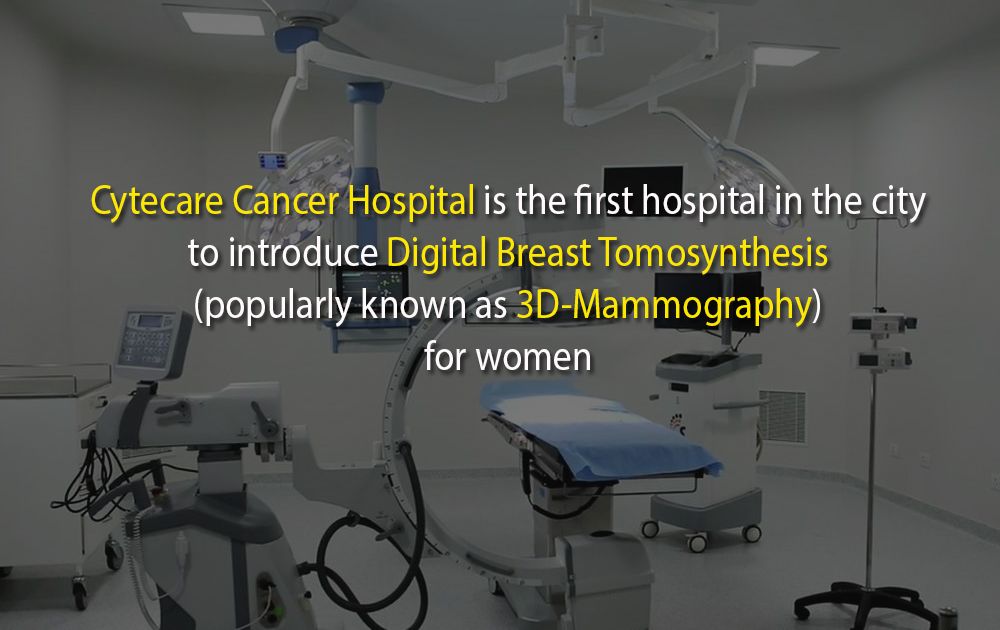Breast Cancer has been ranked as the number one cancer among Indian women with age adjusted rate as high as 25.8 per 100,000 women, as per the latest statistics published in the Asia Pacific Journal of Clinical Oncology. Bengaluru has ranked third with age adjusted incidence rate of carcinoma of the breast found as high as 34.4 per 100,000 women. Projections for India suggest the number of breast cancer cases will likely go as high as 1,797,900 by 2020. Though there has been an increase in health check-ups among women recently and we can still see that screening is low on priority even in major cities.
Cytecare hospital is the first hospital in the city to introduce Digital Breast Tomosynthesis (popularly known as 3D-Mammography) for women.
Mammography continues to be the only screening test proven to decrease mortality from breast cancer. However, 2D mammography is less accurate in women with dense breasts for whom cancer may be masked by overlapping breast tissue. When a 2D mammogram detects an area of concern, radiologists further investigate with a diagnostic mammogram, ultrasound or biopsy. Looking at the same breast tissue in 3D, the radiologist may now be able to see that the abnormality on 2D mammogram in fact represents normal breast tissue. This avoids further investigation in large number of patients undergoing routine screening.
3D mammography or Tomosynthesis is a special kind of mammogram that uses several low dose x-rays obtained at different angles to create multiple images or “sequential slices” that step through the breast tissue and allows radiologists to see more clearly. The breast is positioned and compressed in the same way as for a 2D mammogram but the x-ray tube moves in a circular arc around the breast. It takes less than 10 seconds for the scan. The information from the x-rays is sent to a computer, which produces a focused 3 D digital image of the breast.
There is no organised national or regional breast cancer screening program in India. Naturally, majority of those involved in women’s health are not aware of the available technology and expertise in the field of breast cancer diagnosis. Needless to say, women undergoing screening have little understanding of the tests or the results thereof.
In contrast to the western world, breast cancer incidence is much higher in premenopausal age group (<50 years) in India. As compared to both screen film and Computed Mammograms (older but most widely used technologies), 2D and 3D Digital Mammography has significantly higher accuracy in cancer detection in younger women and in women with dense glandular breasts. This will have large impact on decreasing the number of women undergoing unnecessary recalls or biopsies. It is most important to avoid anxiety in women opting for screening tests. 3D mammography serves as an excellent problem solving tool and reduces misdiagnoses. Contrary to common practice, ultrasound alone has significant limitations as a screening tool and must always be combined with a 2D or 3D Digital Mammogram. The x-ray dose of 3D mammography is comparable to that of a 2D mammogram. Therefore the cumulative dose of the combined screening is still below the FDA regulated limit and found to be safe and effective for patient use.
Incorporating this aspect Cytecare hospital’s breast imaging services are complete with Digital Breast Tomosynthesis (DBT or 3D Mammogram), Full Field Digital Mammogram (FFDM), Stereotactic and Vacuum Assisted Breast Biopsy (VABB).
3D mammography has shown to reduce percentage of missed cancers by 15%. More recent studies show about 30% increased 3D mammography sensitivity and specificity compared to 2D Mammography with a recalls reduction in screening by approximately 40%.
Want to write for InnoHEALTH? send us your article at magazine@innovatiocuris.com
Read all the issues of InnoHEALTH magazine:
InnoHEALTH Volume 1 Issue 1 (July to September 2016) – https://goo.gl/iWAwN2
InnoHEALTH Volume 1 Issue 2 (October to December 2016) – https://goo.gl/4GGMJz
InnoHEALTH Volume 2 Issue 1 (January to March 2017) – https://goo.gl/DEyKnw
InnoHEALTH Volume 2 Issue 2 (April to June 2017) – https://goo.gl/Nv3eev
InnoHEALTH Volume 2 Issue 3 (July to September 2017) – https://goo.gl/MCVjd6
InnoHEALTH Volume 2 Issue 4 (October to December 2017) – http://amzn.to/2B2UMLw
Connect with InnovatioCuris on:
Facebook: https://www.facebook.com/innovatiocuris
Twitter: https://twitter.com/innovatiocuris
LinkedIn: https://www.linkedin.com/groups/7043791
Stay updated about IC, visit: www.innovatiocuris.com

